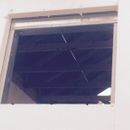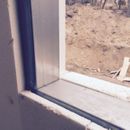Window flashing for new construction
Good morning,
I am getting ready to install windows(aluminum clad) on my new construction and would appreciate help figuring out the flashing details.
The exterior walls are made of gigacrete wall panels. The panels are basically steel studs encased in 8″ thick eps. The walls will get a coating of stuccomax(gigacrete’a proprietary exterior coating). There is 3″ of eps on the outside of the studs so essentially the windows will be inset a little over 3″.
I am attaching a few images so the wall components/window openings can be better understood.
What flashing material should I use, considering it will have to stick to eps?
What width of flashing should I use, considering it will go on the window flanges, then turn 90 degrees to cover a little over 3 inches of foam, and extend out to the outside of the wall/eps?
Any other suggestions?
Please let me know if any clarification is needed on the wall system.
Thanks
GBA Detail Library
A collection of one thousand construction details organized by climate and house part












Replies
Asim,
When you trim out the exterior of your windows, you will need an exterior sill (usually made of sheet metal or solid PVC trim like Azek) and exterior jamb extensions (usually made of the same materials as the sill). However, it's possible that the Gigacrete company recommends their exterior synthetic stucco for use as jamb extensions -- consult them and ask. Personally, I would never use stucco or synthetic stucco for an exterior sill.
You need to consider how these elements will be adhered to your EPS foam. You may need a window buck (usually made of 3/4" plywood) that extends out 3 inches to the exterior of the EPS.
Once you've figured out these details, the rough opening would be flashed the usual way. One quality product to consider would be DuPont FlexWrap.
The usual method is to create a waterproof sill pan on the rough sill. Before this is installed, the rough sill needs to be shimmed so that it slopes to the exterior (or you need to install an interior dam). The flashing needs to lap the WRB on the exterior of the foam (assuming you have a WRB at that location). Then you need to flash the jambs, and the jamb flashing needs to overlap the sill flashing.
One further piece of advice for the benefit of GBA readers: it's important to think through your plans for flashing your window rough openings and trimming the exterior of your windows before you reach the phase of construction shown in Asim's photos.
This detail is actually quite easy but not common place here in the States. In Europe these conditions present themselves on a daily basis so they got it down to a science. For the window flashing you can use SIGA Fentrim 2 it is basically a peel & stick tape that will adhere to the window buck/frame and adhere to the EPS and create an airtight and watertight barrier, yet it is still slightly vapor permeable. The SIGA Fentrim 2 has a lathe surface to it so you can apply the StuccoMax directly to it.
I disagree with Martin on the synthetic stucco and using it as a sill surface. This is done commonly in Europe and here in the States you will see it being used on commercial job sites. StuccoMax is waterproof but it does have some vapor permeability. It also has a 4,000 psi rating at 1/4" thick and contains NO Portland cement so cracking is almost non-existent.
Just attach the SIGA Fentrim to the window area and then carry it down over the EPS and terminate it just before the vertical wall plane. That creates your air/water barrier. Apply StuccoMax to the Fentrim and trowel it up to the window frame and down the wall plane. You're done. You have 2 layers of water/air protection; the StuccoMax & the SIGA Fentrim.
See here: http://www.siga.ch/en/product-overview/detail-fentrim-2.html
You can use SIGA Fentrim 20 on the interior window area IF you are applying StuccoMax to the interior EPS. Otherwise just use SIGA WigLuv on the interior. That window area will be bulletproof air and water tight. Just remember that StuccoMax dries VERY QUICKLY and you have about 30 minutes of workability with it and that is when temps are below 85F.
Peter,
Thanks for your very specific advice, which is based on more experience than my advice. I appreciate it.
I still don't like using synthetic stucco for an exterior sill, but you provide a convincing argument that this method can work.
Martin,
Thanks for the response. I will reply to your post in detail later this evening.
Peter,
Thanks a lot for the very specific information involving stuccomax. I tried to lookup the availability of fentrim online, but was unsuccessful. The couple websites that usually carry siga tapes don't seem to have fentrim. Where would I be able to find it?
Martin,
Sorry for the delayed response.
You are correct that the details need to be figured out before reaching this stage of the construction. I did have conversations with gigacrete specifically about the window insall/flashing before I started and had a general plan of what I would be doing.
Since I am at this stage now, I am researching again just to make sure that I don't miss anything.
Just so respond to some of your comments, gigacrete does recommend attaching foam over the flashing and "stuccoing" to achieve the exterior jamb extensions.
Also, there is no "additional" WRB - the wall system is composed of 8 inches of continuous EPS encasing the steel studs. The Framing sits 3" inside of the foam. The final component of the system is stuccomax plastered on the outside. So the whole system is a WRB I guess.
So would you still recommend against a stucco sill considering the wall system?
I did get a sample of flexwrap and currently have it on a window sill just to see it stickiness to the foam. So far it is holding up pretty good. I have worked out the flashing details which I will post later to get opinions on it. One question I did have was, what would your opinion be about using something like protectowrap or a non DuPont flashing tape for the jambs and the header while using flexwrap for the sill?
Asim,
You are using a proprietary system called Gigacrete. Since you have specified the system, I assume that you trust the manufacturer. That means that you should follow the manufacturer's instructions, and assume that their system will result in a waterproof wall assembly.
If water enters your wall assembly -- and I'm not predicting that it will -- I assume that you will hold the Gigacrete company liable for the system they have designed and manufactured.
This approach -- choosing a manufacturer you trust, and following the manufacturer's recommendations -- works well for reputable companies, and less well for companies that aren't so reputable. I have no experience with the Gigacrete system.
Martin,
Fair enough.
I trust Gigacrete and have discussed the details with them which I will be using.
I guess I was looking more for opinions on various flashing materials than the flashing details, since same detail can be achieved using different brands and some brands perform better than the others.
You did mention flexwrap which I am testing and will end up using most probably. Peter recommended the Siga tape, so I guess I did accomplish what I was looking for by posting my question.
Thanks
Asim
Asim,
What state are you building this home?
SIGA Fentrim is available from local authorized reps. The advantages of SIGA is that it is a time tested and vapor open product which is not true with most other tapes. It also has no VOCs which cannot be said for most other tapes. Whatever you end up using you MUST verify that it doesn't harm EPS as most products with VOCs/petroleum based adhesives will melt and damage EPS. Most tapes are meant for wood applications so they contain petroleum based bu-products.